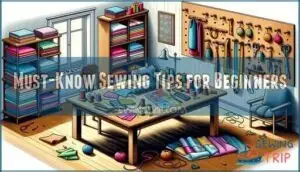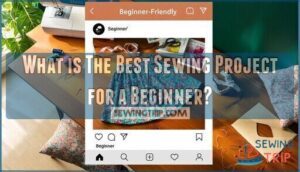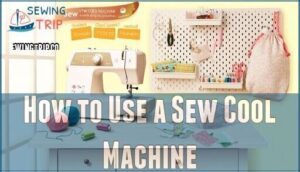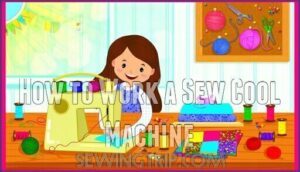This site is supported by our readers. We may earn a commission, at no cost to you, if you purchase through links.
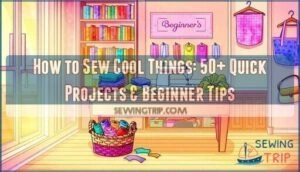
Start with scrunchies—they’ll take just five minutes and teach you basic seams. Move on to envelope pillow covers during your lunch break, then try fabric coasters using simple cotton squares and straight stitching.
These quick wins build your confidence fast. Pick forgiving fabrics like cotton broadcloth or jersey knits that hide mistakes and don’t require perfect precision.
Simple pouches make great coin purses or key fobs, while basic tote bags introduce handle attachment techniques. The secret isn’t complex patterns—it’s choosing projects that look sophisticated but use fundamental skills you can master in one afternoon.
Table Of Contents
- Key Takeaways
- Quick and Easy Sewing Projects
- Sew Cool Machine Review
- Must-Know Sewing Tips for Beginners
- What is The Best Sewing Project for a Beginner?
- How to Thread a Sew Cool Machine
- How to Sew With a Sew Cool Machine
- How to Use a Sew Cool Machine
- How to Work a Sew Cool Machine
- Frequently Asked Questions (FAQs)
- Conclusion
Key Takeaways
- Start with 5-minute wins like scrunchies – You’ll build confidence fast and master basic seams without the pressure of complex projects
- Choose forgiving cotton fabrics – They hide your mistakes and don’t require perfect precision, making your learning curve much smoother
- Pick projects that look sophisticated but use basic skills – Simple totes and envelope pillows appear professional while teaching you fundamental techniques you can master in one afternoon
- Focus on clean finishing over complex patterns – You’ll achieve that polished, store-bought look by perfecting simple techniques rather than attempting advanced designs
Quick and Easy Sewing Projects
You’ll discover that creating cool sewing projects doesn’t require years of experience or expensive equipment.
From quick projects like scrunchies that take five minutes to envelope pillow covers you can finish during your lunch break, these handmade items prove that handmade doesn’t mean time-consuming.
Things to Sew in Under 10 Minutes
When you need instant gratification from your sewing machine, these lightning-fast projects deliver maximum satisfaction with minimal time investment.
Perfect for last-minute Quick Gifts or spontaneous creativity bursts, these Mini Crafts transform fabric scraps into functional treasures.
For more ideas on creating personalized gifts, consider exploring sewing gift ideas.
- Scrunchies: Stitch fabric strips with elastic in minutes for trendy Baby Accessories
- Fabric coasters: Create Fast Decor using straight seams and cotton squares
- Simple Pouches: Whip up coin purses or key fobs for quick sewing projects that impress
Projects for Beginners
When you’re ready to tackle beginner sewing projects, start with foolproof options that build confidence.
A Simple Skirt requires just basic measurements and straight seams, while a Baby Headband teaches you to work with stretchy fabrics.
Try an Envelope Pillow cover—it’s practically mistake-proof since there’s no zipper involved.
A Tote Bag introduces handles and reinforcement techniques, and an Apron covers essential skills like bias tape application.
These easy sewing projects use forgiving fabrics like cotton, making them perfect sewing tutorials for beginners learning fundamental techniques.
Sewing Projects as Gifts
Nothing beats the joy of gifting something you’ve crafted with your own hands.
Handmade gifts carry special meaning that store-bought items simply can’t match. Your loved ones will treasure these personalized items for years to come.
Here are thoughtful Gift Ideas you can create:
- Sewn Toys – Stuffed animals, fabric dolls, or sensory toys for little ones
- Fabric Gifts – Custom tote bags, cozy scarves, or decorative pillows
- Handmade Bags – Drawstring pouches, zipper cases, or laptop sleeves
- Personalized Items – Embroidered stockings, monogrammed napkins, or custom bookmarks
One-Hour Sewing Projects
Transforming fabric into functional treasures doesn’t require marathon sessions at your machine.
You can create meaningful handmade gifts in just sixty minutes:
- Simple Skirts – Perfect beginner-friendly garments using basic straight seams
- Baby Headbands – Adorable accessories requiring minimal fabric and time
- Envelope Pillows – Home décor upgrades with foolproof construction techniques
These sewing projects for beginners prove that easy sewing projects under an hour deliver impressive results without overwhelming your schedule.
Most Forgiving Fabrics
Cotton fabrics like broadcloth and quilter’s cotton offer beginner-friendly sewing with their stable weave and forgiving nature.
Cotton’s forgiving weave turns sewing mistakes into beautiful learning moments
Cotton’s stable weave makes mistakes disappear into beautiful, forgiving creations every time.
Knit materials such as jersey fabric provide stretch and comfort while hiding mistakes beautifully.
Fleece textiles grip together naturally, requiring fewer pins. Soft denim and other midweight cottons press easily and resist fraying, making them sewing essentials for simple sewing projects.
For more information on suitable materials, consider exploring beginner sewists resources to find the perfect fabric for your needs.
Free Sewing Patterns
Free sewing patterns open up endless DIY projects without breaking the bank.
You’ll find beginner-friendly options that transform fabric scraps into stunning creations.
Start with these game-changing free patterns:
- Envelope pillow covers – Master clean lines and professional finishes
- Drawstring pouches – Perfect for travel organization and gift-giving
- Simple tote bags – Build confidence with straight seams and handles
- Baby headbands – Quick wins that boost your sewing motivation
- Scrunchies – Practice gathering techniques on forgiving cotton fabrics
These sewing tutorials teach fundamental skills while creating useful items you’ll actually love.
Sew Cool Machine Review
You’ve probably seen the Sew Cool machine promising needle-free sewing magic for kids, but does it actually deliver on those bold claims?
Let’s break down what this popular craft toy can and can’t do, plus explore some alternatives that might spark even more creativity in your young maker.
Other Top Toys for The Creative Child
Beyond the Sew Cool machine, you’ll discover amazing Creative Play options that spark imagination.
Consider owl stuffies and stuffed kitty pillow projects for cozy companions. Kids Crafts like mermaid costume and pirate costume designs let children become their favorite characters.
Art Projects including sock monkey puppet creation blend Toy Making with storytelling. These Imagination Games develop fine motor skills while encouraging creative expression through hands-on making.
When choosing a sewing machine, consider the best machines for kids to guarantee a fun and educational experience.
Tips for Getting The Best Price on Top Toys
Smart shopping saves you money on creative toys without sacrificing quality.
Smart shopping means finding amazing deals without settling for cheap junk that breaks after one use
Hunt for toy sales during post-holiday clearance events when prices drop 50-70%. Use price comparison tools and stack discount codes with cashback offers for maximum savings.
Check online deals at major retailers like Target and Amazon, especially during Prime Day.
These bargain hunting strategies help fund more DIY gifts and sewing projects for kids.
When purchasing a Sew Cool Machine, consider the official Sew Cool products to guarantee authenticity and compatibility.
Must-Know Sewing Tips for Beginners
Building strong sewing basics sets you up for creative success.
Smart fabric choice and proper thread selection can make or break your first project—cotton fabrics forgive mistakes while polyester threads provide durability.
Master these fundamentals before touching your sewing tools:
- Choose beginner-friendly fabrics – Cotton wovens behave predictably, while stretchy knits can frustrate newcomers
- Match thread weight to fabric – Heavy denim needs thick thread, while delicate silks require fine options
- Practice pattern making on paper first – Understanding how pieces fit together prevents costly fabric mistakes
Your sewing techniques will improve naturally when you’re not fighting inappropriate materials.
Quality sewing tools don’t have to be expensive, but they should be sharp and functional.
Start with basic projects that let you practice straight seams and simple hems.
Remember, even experienced sewists began with wobbly stitches—patience beats perfection every time.
What is The Best Sewing Project for a Beginner?
When starting your sewing journey, you’ll want projects that build confidence without overwhelming your skills.
The best beginner-friendly sewing projects combine simple techniques with practical results that you’ll actually use.
| Project Type | Time Required | Key Skills Learned |
|---|---|---|
| Simple Skirt | 2-3 hours | Elastic waistbands, hemming |
| Baby Headband | 15 minutes | Curved seams, stretch fabric |
| Envelope Pillow | 30 minutes | Measuring, straight seams |
| Tote Bag | 1 hour | Handles, reinforcement |
| Apron Sewing | 45 minutes | Ties, pockets, topstitching |
These sewing projects for beginners teach fundamental skills while creating useful items.
Start with an envelope pillow – it’s forgiving and teaches precise measuring.
Once you’ve mastered straight lines, try a tote bag for handle attachment practice.
The simple skirt introduces elastic waistbands, while baby headbands help you work with stretchy materials.
These easy sewing projects create a solid foundation for more complex work ahead.
Mastering beginner sewing techniques is essential to move on to more challenging projects.
How to Thread a Sew Cool Machine
Threading your Sew Cool Machine correctly sets the foundation for every successful project you’ll tackle. This needle-free sewing machine uses special threading techniques that differ from traditional machines, making it perfect for young crafters ready to jump into sewing basics.
Start by lifting the thread guide and placing your thread spool on the spindle. Pull the thread through the tension disc – this controls your thread tension and prevents loose stitches. Next, guide the thread down through the threading path, following the numbered sequence on your machine. The thread should pass through the take-up lever and down to the needle area.
- Check thread tension regularly – loose threads create messy stitches while tight threads can break mid-project
- Keep extra thread spools handy – running out halfway through threading disrupts your creative flow
- Clean the threading path monthly – lint buildup affects machine maintenance and stitch quality
- Practice threading without fabric first – mastering threading techniques builds confidence for actual sewing projects
Proper bobbin management comes next, ensuring your Sew Cool Machine runs smoothly for all your creative adventures ahead. Understanding thread tension settings is vital for achieving flawless stitches and maintaining your machine’s performance.
How to Sew With a Sew Cool Machine
Now you’re ready to bring your Sew Cool machine to life. This no-thread wonder uses three safety-guarded needles to bond felt pieces through a unique felting process.
Simply align your fabric with the seam guide, press the button to start, and guide the material slowly through the machine for stronger seams.
Sew Cool Basics for successful projects:
- Use only Sew Cool or compatible felt fabric to prevent jams
- Sew just two layers at a time for best results
- Move fabric slowly – you control the speed and stitch quality
- Spot-stitch at marked points before final seaming
- Leave stuffing gaps for plush items, then close after filling
The machine’s light indicators help with Machine Troubleshooting when issues arise. If jamming occurs, switch off, raise the needles with the side knob, and remove fabric before resetting.
This sewing machine alternative eliminates thread complications while delivering impressive Cool Projects. From purses to plush animals, you’ll master essential Sewing Techniques through hands-on practice with this innovative sewing machine.
How to Use a Sew Cool Machine
Once you’ve mastered the Sew Cool Basics, it’s time to discover your machine’s full creative potential.
This compact sewing machine transforms everyday materials into personalized treasures through simple sewing techniques and smart fabric selection.
The Sew Cool Machine excels at beginner-friendly projects that don’t require complex sewing machine features. Start with cotton fabrics—they’re forgiving and easy to handle.
When you encounter sewing machine troubleshooting issues, check your thread tension and needle position first.
Here are Cool Projects that’ll boost your confidence:
- Face masks using colorful cotton scraps for style and protection
- Drawstring pouches from old t-shirts for organizing school supplies
- Pillow covers with envelope closures for instant room makeovers
- Simple tote bags perfect for carrying your latest creations
Don’t stress about perfection—every wobbly seam teaches you something new. The real magic happens when you stop overthinking and start experimenting. Your sewing basics will improve naturally as you tackle each project with curiosity and creativity.
How to Work a Sew Cool Machine
Working with your Sew Cool machine becomes second nature once you understand the Machine Basics. You’ll master Fabric Selection and Thread Management through hands-on practice with this kid-friendly sewing machine.
Here’s your step-by-step approach to sewing machine mastery:
- Thread properly – Load both top thread and bobbin following your manual’s diagrams
- Choose your settings – Select appropriate stitch type and adjust tension for your fabric
- Position fabric correctly – Place material under presser foot and lower it securely
- Start slowly – Hold thread tails while beginning to stitch, maintaining steady pressure
- Guide gently – Let the machine do the work while you provide directional control
Effective Sewing Techniques develop through repetition. Your Stitch Control improves with each project you tackle. Don’t worry about perfection—even seasoned sewers started somewhere! This machine’s forgiving nature makes it perfect for building confidence.
When you encounter sewing machine troubleshooting issues, check threading first. Most problems stem from improper setup. The sewing machine features designed for beginners help prevent common mistakes, making your creative journey smoother and more enjoyable. Understanding the sewing machine mechanics is essential for efficient sewing and troubleshooting.
Frequently Asked Questions (FAQs)
What is the easiest item to sew?
Like picking the perfect starter thread in a tapestry, scrunchies are your golden ticket to sewing success.
You’ll master straight lines using any fabric, needle, and thread—cotton‘s your best friend here.
This simple hair accessory builds confidence while you’re learning the ropes.
What are some good sewing projects?
Start with scrunchies or envelope pillow covers—they’re quick wins that’ll boost your confidence.
Try tote bags, aprons, or drawstring pouches next.
Once you’re comfortable, tackle canvas log bags or waterproof book covers for cooler projects.
What advanced stitches create professional-looking garments?
Professional sewers master four key stitches: French seams eliminate raw edges, blind hems create invisible finishes, buttonholes require precise tension, and topstitching adds structure.
You’ll transform homemade into haute couture instantly.
How to choose between serger and regular sewing machine?
Choose a serger for finishing edges, stretchy fabrics, and professional-looking seams.
Pick a regular machine for versatility, decorative stitches, and detailed work.
You’ll likely need both eventually—start with what matches your current projects best, focusing on versatility.
What interfacing works best for structured collars?
Fusible medium-weight interfacing becomes your collar’s backbone—it’ll keep those points sharp and prevent flopping.
You’ll want something with enough structure to hold its shape but flexible enough to turn cleanly through those tricky corners, making Fusible medium-weight interfacing a crucial component, and ensuring it has enough structure.
How to alter patterns for different body shapes?
Adjust patterns by measuring your body and comparing to pattern measurements. Add or subtract length at designated lines. For curves, blend adjustments gradually using French curves. Make test garments first.
What troubleshooting fixes common thread tension problems?
Check your upper thread tension dial—too tight creates puckering, too loose makes loose stitches.
Re-thread completely, clean your machine’s tension discs, and test on fabric scraps before continuing your project.
How to choose thread color for projects?
Like a chameleon’s instinct to blend with bark, your thread should harmonize with your fabric’s dominant tone.
Match exactly for invisible seams, go one shade darker for subtle definition, or contrast boldly for decorative stitching that pops.
Reorganizing thread colors is crucial for achieving the desired aesthetic, whether it’s for fashion, upholstery, or crafts.
What tension setting works best for beginners?
Start with medium tension (around 4-5 on most machines) and test on fabric scraps first.
You’ll avoid puckering and skipped stitches while learning proper technique and building confidence with consistent results.
How to prevent fabric from puckering while sewing?
Fabric puckering’s like wrestling stubborn fabric that won’t cooperate. Use proper needle size for your fabric weight, maintain consistent thread tension, and guide—don’t pull—fabric through steadily.
Conclusion
Mastering how to sew cool things doesn’t require years of training—just smart project choices.
You’ve discovered that scrunchies, pillow covers, and simple totes can look impressively professional while building essential skills.
Start with forgiving fabrics like cotton that hide beginner mistakes.
Remember, sophistication comes from clean finishing, not complex patterns.
Your sewing machine awaits, and these projects prove that learning how to sew cool things happens faster than you think.
- https://sewcanshe.com/the-24-most-popular-free-sewing-patterns-from-2024/
- https://www.sumoftheirstories.com/blog/easy-sewing-projects-that-are-perfect-for-beginners
- https://lacreativemama.com/beginners-guide-sewing-crafts/
- https://www.youtube.com/watch?v=1x8Cw-fj8Ic
- https://www.dreamcutsew.com/spring-2025-trends-sewing-inspiration/


